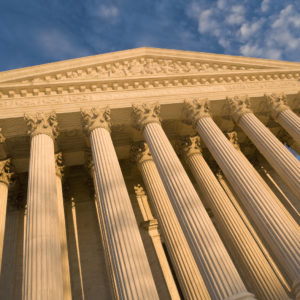Decided on February 24, 1803, Marbury v. Madison is considered one of the most important Supreme Court cases in American history, affirming the court’s power to interpret the Constitution and declare federal laws void if they violate the Constitution.
The case involved William Marbury, who was one of the “midnight judges” appointed at the last minute by outgoing President John Adams, who had lost a bitter re-election campaign to Thomas Jefferson in 1800. Marbury’s appointment as Justice of the Peace for the District of Columbia was never completed because Jefferson ordered his new secretary of state, James Madison, not to deliver the necessary documents. Marbury asked the Supreme Court to force Madison to hand over his “commission” under Section 13 of the Judiciary Act of 1789. While the Court agreed that Marbury had a right to his commission, it ruled that Section 13 was unconstitutional and therefore it could not order Madison to give Marbury his commission.
The quiz below, from the Ashbrook Center at Ashland University in Ohio, provides an opportunity for you to test your knowledge of Marbury v. Madison and the Supreme Court.
1. President Jefferson opposed “midnight judges” like Marbury because he believed they would support his rival political party:
A. The Democratic-Republican Party
B. The Federalist Party
C. The Socialist Party
D. The Know Nothing Party
2. Jefferson’s secretary of state, James Madison, was from what state?
A. Massachusetts
B. Ohio
C. New York
D. Virginia
3. Which Supreme Court justice wrote the opinion in Marbury v. Madison?
A. John Jay
B. Roger Taney
C. John Marshall
D. William Howard Taft
4. Which part of the Constitution outlines the Supreme Court’s “judicial power”?
A. The Fourth Amendment
B. Article III
C. The Preamble
D. The “take care” clause
5. What kind of judicial order did Marbury want the Supreme Court to issue to Madison in order to force him to hand over Marbury’s commission?
A. Writ of mandamus
B. Search warrant
C. Subpoena
D. Writ of habeas corpus
6. Which of the following lines are in Marbury v. Madison?
A. “We are under a Constitution, but the Constitution is what the judges say it is”
B. “clear and present danger”
C. “It is emphatically the province and duty of the judicial department to say what the law is”
D. All of the above
7. What do we call the power of the Supreme Court to declare a law unconstitutional?
A. Judicial review
B. Oral argument
C. Rule of four
D. Legislative veto
8.After the Marbury v. Madison decision in 1803, the Supreme Court struck down a major federal law 54 years later in this famous case:
A. Roe v. Wade
B. Brown v. Board of Education
C. Plessy v. Ferguson
D. Dred Scott v. Sandford
9. The Marbury decision was delivered in a boarding house because the Supreme Court had no permanent location in 1803. When did the Court get its own building?
A. 1810
B. 1860
C. 1935
D. 2013
10. What phrase is inscribed on the front façade of the Supreme Court building?
A. “Eternal vigilance is the price of liberty”
B. “Equal justice under law”
C. “The highest court in the land”
D. “Four score and seven years ago”
Answers: 1. B; 2. D; 3. C; 4. B; 5. A; 6. C; 7. A; 8. D; 9. C; 10. B

